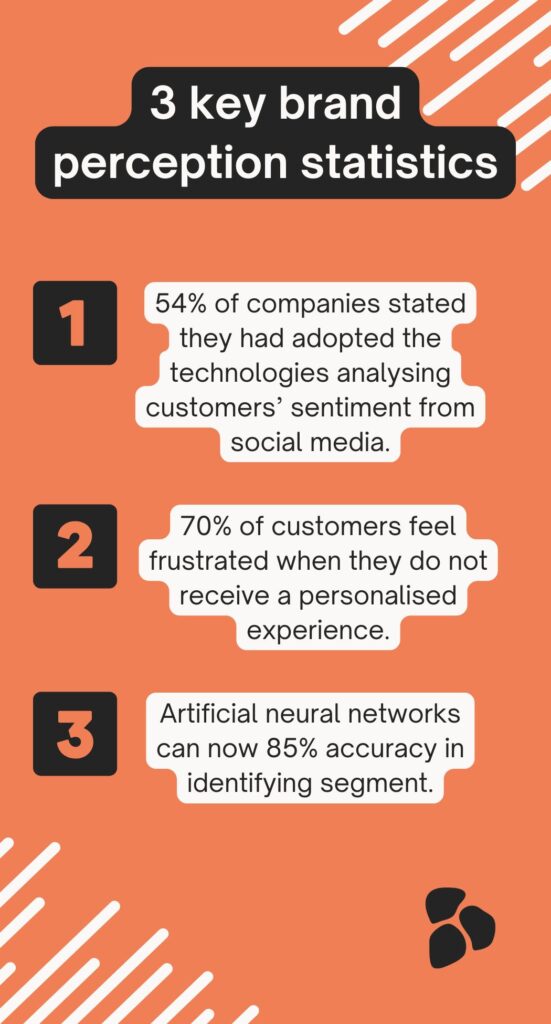Every day on social media, brands clash for consumer attention, and understanding public sentiment is akin to having a soothsayer on your payroll. Enter sentiment analysis: the art and science of deciphering the emotional undertones of social media chatter.
It's like having a superpower that lets you read between the lines of every tweet, post, and comment about your brand. But before we dive into the deep end of this algorithmic pool, let's set the stage for why you, dear marketing maestro, should care.
The Digital Pulse of Brand Perception
Picture this: Your latest campaign just dropped. The creative team is high-fiving, the client is giddy, and you’re quietly hoping this doesn’t become another “New Coke” fiasco. In the pre-digital era, you’d be fumbling in the dark, waiting for sales figures or focus groups to tell you if you’ve hit the mark. Today? The internet lights up like a Christmas tree with instant reactions. But here’s the rub – deciphering whether that glittering response is a string of celebratory lights or an angry mob with torches isn’t always straightforward.
As the inimitable Oscar Wilde once quipped, “There is only one thing in the world worse than being talked about, and that is not being talked about.” In the social media age, Wilde might have added, “But for heaven’s sake, know what they’re saying!”
Sentiment Analysis 101: More Than Just Thumbs Up or Down
At its core, sentiment analysis is about understanding emotions expressed in text. It’s the digital equivalent of reading a room, but instead of body language, you’re interpreting emojis, caps lock, and the nuanced use of “literally” to mean anything but.
Types of Sentiment Analysis: Fifty Shades of Feel
- Fine-grained Analysis: This isn’t just positive, negative, or neutral. It’s the difference between “meh” and “mind-blown” or “slightly peeved” and “ready to torch HQ.”
- Emotion Detection: Because sometimes “happy” just doesn’t cut it. Are your customers ecstatic, amused, or just politely pleased?
- Aspect-based Analysis: You need to know if they love your product but hate your customer service (or vice versa).
The Nuts and Bolts
Sentiment analysis systems typically involve:
- Data Collection: Scouring the internet for mentions of your brand. It’s like eavesdropping, but ethical and at scale.
- Text Preprocessing: Cleaning up the data. Think of it as digital hygiene for your brand mentions.
- Sentiment Classification: The actual mood-decoding part. This is where the magic (read: complex algorithms) happens.

Social Media: Where Sentiments Run Wild and Free
Analysing sentiment on social media is like trying to conduct a symphony orchestra where every musician plays a different song; some are shouting the lyrics and a few are just there for the free snacks.
The Challenges
- Sarcasm: Because nothing says “I love your product” quite like “Oh great, another software update. Just what I needed to complete my day.”
- Brevity: Turns out, 280 characters can pack quite the emotional punch.
- Multilinguality: Your brand might be global, but is your sentiment analysis?
The Opportunities
- Real-time Feedback: Catch a PR crisis before it catches fire.
- Trend Prediction: Be the crystal ball your C-suite has always wanted.
- Competitive Analysis: Know what people think about your competitors. It’s not spying; it’s “market research.”
Getting Techy With It: Advanced Sentiment Analysis
For those who like their marketing with a side of computer science, here’s where things get interesting.
Machine Learning: Teaching Computers to Feel
- Supervised Learning: Like teaching a child to recognize emotions, but with more data and less ice cream as rewards.
- Unsupervised Learning: Letting the algorithm figure it out. It’s either brilliant or terrifying, depending on your perspective.
- Deep Learning: For when you want your sentiment analysis with a side of skynet.
NLP: Because Language is Hard, Even for Humans
Natural Language Processing is the backbone of advanced sentiment analysis. It’s what helps algorithms understand that “This product is the bomb” is (probably) positive, while “This product bombed” is decidedly not.
Multimodal Analysis: Because a Picture is Worth a Thousand Sentiments
Text is great, but what about memes, reaction GIFs, and videos? Multimodal analysis looks at the whole package because sometimes the most potent reactions aren’t put into words.
Putting Sentiment Analysis to Work: From Insights to Action
Having all this sentiment data is excellent, but if you’re not using it, you’re just hoarding digital emotions. Here’s how to make it count:
- Choose Your Weapons: Select tools that fit your needs and budget—no need for a sentiment analysis bazooka if a pistol will do.
- Set Your Targets: Establish clear metrics. What’s your sentiment north star?
- Integrate and Conquer: Weave sentiment analysis into your broader marketing strategy. It should inform decisions, not just be a fancy report you wave around in meetings.
Brand Sentiment Tools and Software: Your Digital Emotion Detectors
Now that we’ve covered the “why” and “what” of sentiment analysis, let’s dive into the “how.” The market is awash with tools promising to be your brand’s digital mood ring. But fear not, intrepid marketer, for we shall navigate these waters together.
The Swiss Army Knives of Sentiment Analysis
Sprout Social
Not just a pretty face in social media management, Sprout Social offers robust sentiment analysis features, allowing you to uncork those bottled-up customer emotions.
Hootsuite Insights
Hootsuite isn’t just for scheduling those witty tweets. Their Insights feature offers sentiment analysis that can help you understand whether your audience is laughing with or at you.
Brandwatch
If Sherlock Holmes were software, he’d be Brandwatch. This tool doesn’t just analyse sentiment; it practically reads the tea leaves of social media trends.
The Specialised Sentimentalists
Lexalytics
This is for when you need to get granular with your sentiment analysis. It’s like having a microscope for emotions, letting you zoom in on specific aspects of your brand perception.
Qualtrics XM (Formerly Clarabridge)
This isn’t just sentiment analysis; it’s customer experience management on steroids. Qualtrics XM helps you connect the dots between sentiment and actual customer behaviour.
Repustate
Multilingual sentiment analysis is the bread and butter of this all-in-one sentiment analysis platform. Because feelings are universal, but the ways we express them aren’t.
The Budget-Friendly Brand Listeners
BrandMentions
For when you want to dip your toes into sentiment analysis without diving into the deep end of your budget pool. The tools monitors what’s being said about your company on web and social.
Talkwalker
Now part of Hootsuite, Talkwalker offers a free social search tool with basic sentiment analysis. Has an intuitive design, making it easy to keep on top of social listening.
Prowly
A media monitoring tool that allows you to track press hits and social mentions across the web. It uses advanced filters and AI to help you focus on the mentions that matter the most.
Choosing Your Sentiment Sidekick
Selecting the right tool is like choosing a dance partner for the grand ball of public opinion. Here are some factors to consider:
- Scale: Are you a small business dipping your toes in the sentiment waters or a multinational corporation cannonballing into the deep end?
- Depth of Analysis: Do you need a simple positive/negative/neutral breakdown, or are you looking for nuanced emotion detection that can tell the difference between “mildly peeved” and “about to start a Twitter revolution”?
- Integration: How well does the tool play with others? Can it seamlessly slip into your existing marketing tech stack, or is it the digital equivalent of trying to fit a square peg in a round hole?
- Language Support: If your brand speaks in tongues (figuratively), you’ll need a tool that can keep up. Some tools are linguistic virtuosos, while others are stubbornly monolingual.
- User-Friendliness: Because life’s too short to spend it deciphering a user interface that looks like it was designed by a committee of cryptographers.
- Customization: Can you teach the tool your brand’s unique language, or are you stuck with off-the-shelf sentiment detection?
- Reporting: Look for tools that don’t just collect data but tell a story. Bonus points if they can make a bar chart look sexy.
- Price: Because at the end of the day, someone in finance is going to ask, “What’s the ROI on understanding feelings?”
Implementing Your Chosen Tool
Once you’ve selected your sentiment analysis soulmate, it’s time to put it to work:
- Start Small: Begin with a pilot project. Maybe analyse sentiment around a specific campaign or product launch.
- Train Your Team: Ensure your marketing team knows how to use the tool effectively. A powerful sentiment analysis tool in untrained hands is like giving a toddler a smartphone – entertaining, but potentially disastrous.
- Establish Baselines: Before you can improve sentiment, you need to know where you stand. Establish benchmarks for normal sentiment levels.
- Set Up Alerts: Most tools offer alert systems. Set these up to catch sudden shifts in sentiment before they become full-blown PR crises.
- Integrate Insights: Make sentiment data a regular part of your marketing meetings. It should inform strategy, not just be a fancy slide in your presentation.
- Continuous Learning: The tool will get smarter over time, but only if you teach it. Regularly refine its understanding of your brand’s specific context.
Remember, these tools are meant to augment your marketing intuition, not replace it. They’re incredibly powerful, but they’re not mind readers (yet). Use them wisely, and you’ll gain unprecedented insight into your brand’s perception.
In the end, the best sentiment analysis tool is the one that helps you turn the digital noise into a symphony of actionable insights. Choose wisely, use creatively, and may the sentiment be ever in your favor.
Wrapping Up: The Sentiment of It All
In the end, sentiment analysis is about understanding people better. It’s a powerful tool, but remember – behind every data point is a real person with real feelings. Use this power wisely, and you might just create brand experiences that people genuinely love.















